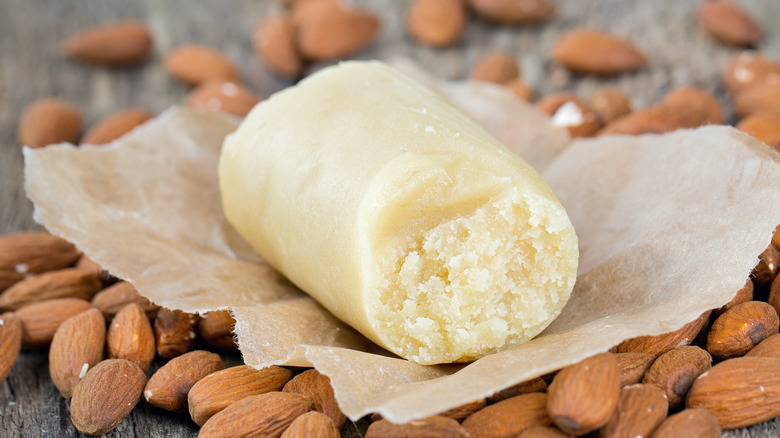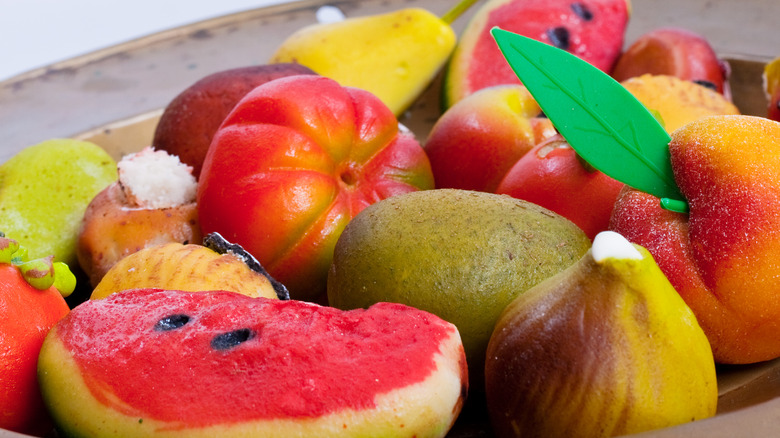Marzipan Vs. Almond Paste: What's The Difference?
In the culinary world, there are a host of terms so similar that they can sometimes cause confusion. Do you know the difference between canapés and hors d'oeuvres, or marzipan and frangipane? Or that shrimp and prawns are different species?
Food and Wine explains that marzipan and almond paste are two of these terms that may seem interchangeable at first. You're probably already familiar with marzipan, the soft, sweet confection made from almonds that often shows up in shops around Christmastime. However, unless you're a seasoned baker, you may not be familiar with almond paste. You'd be forgiven for confusing the two, though: after all, isn't marzipan a paste made of almonds?
Well, yes, technically marzipan is a paste made of almonds. However, as Bon Appetit explains, the term "almond paste" specifically refers to a separate food. Like marzipan, almond paste is a sweetened paste made from ground almonds, often bound together with egg and sugar syrup. But despite their similarities, it's important to know the difference. Read on to learn what makes them unique.
What is marzipan?
Compared to almond paste, marzipan has a smooth, pliable texture. It tastes different, too: marzipan has more sugar and fewer almonds than almond paste, so it has a sweeter, less intense flavor.
Food and Wine explains that marzipan can serve a similar purpose to fondant: it can be rolled into flat sheets to drape over cakes or molded into shapes for an attractive yet tasty decoration. While almond paste is typically incorporated into baked goods, marzipan is often eaten as-is. You've likely seen it shaped into brightly colored — and sometimes shockingly realistic — fruits and vegetables.
According to Serious Eats, marzipan was allegedly invented in Lübeck, Germany, in the 15th century. When a famine left bakers without bread flour, they turned to almonds. Lübeck isn't the only city to say they invented marzipan, though. Venice, Florence, and Konigsberg all lay claim to the sweet treat.
While marzipan is now found around the world, it is most popular in Europe, where there are regional variations and traditions. Germans celebrate the winter season with Christmas stollen, a sweet bread stuffed with marzipan. Scandinavian countries have marzipan pigs to usher in good luck.
What is almond paste?
While marzipan is eaten as-is or used as a decoration, almond paste is typically mixed into other confections as an ingredient. It's used in cakes, galettes, and classic Italian rainbow cookies.
Compared to marzipan, almond paste has a coarse texture and rich, nutty flavor. Food Network explains that marzipan is often one part ground almonds to two parts confectioners' sugar, while almond paste typically uses a half-and-half almond-to-sugar ratio. Since almond paste doesn't have as much sugar as marzipan, you can easily add it to pastries without worrying about making them too sweet.
Like marzipan, almond paste is easy to craft at home. Bon Appetit recommends blending blanched almonds in a food processor with sugar, almond extract, and rum. It's a simple process, but it can take time — so if you're looking for a shortcut, use almond flour. You can also add egg white to help bind the ingredients together.
Are marzipan and almond paste interchangeable?
While you might come across recipes that mistakenly use the terms "marzipan" and "almond paste" interchangeably, they're different ingredients with different purposes.
Bon Appetit explains that, since marzipan and almond paste have distinctly different flavors and textures, they shouldn't be used interchangeably. If your recipe calls for almond paste, marzipan will throw off the ratios and taste excessively sweet. Conversely, almond paste won't work as well as marzipan for candies or cake decoration. The coarse texture of almond paste won't look as nice as smooth marzipan, and you'll probably find yourself struggling to get it to hold its shape.
However, the two ingredients can be substituted in a pinch, especially if it's inside the dish, rather than used like fondant. If your recipe calls for almond paste and you only have access to marzipan, reduce the amount of sugar in your recipe to compensate for the high sugar content of the marzipan. And if you only have access to almond paste, add more sugar.



